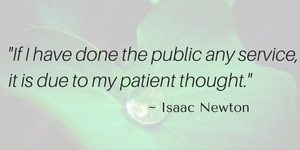 Patience: “The ability to remain calm and not become annoyed when waiting for a long time or when dealing with problems or difficult people”, per Merriam-Webster.
Patience: “The ability to remain calm and not become annoyed when waiting for a long time or when dealing with problems or difficult people”, per Merriam-Webster.
If we as leaders have a consistent shortcoming other than being poor listeners, it is probably our lack of patience.
And why should we? Far better in most cases to drive the team to a decision sooner than later, to push aside naysayers and doubters, right? In some cases that’s absolutely what great leaders do. Over and over, we have seen the dramatic results that come from rapid decisions and personal will exhibited by visionary, Level Five leaders. Think of the decision to take down Osama Bin Laden.
But wait. There are other times when quick decisions can have disastrous consequences. Think of some in your organization. What could you have done to prevent those outcomes? In most cases, you can probably trace the root cause back to the lack of tactical patience (a key subset of patience overall).
Tactical patience is the ability to pause and refocus, make sure the mission is clearly the main thing we are doing. I’ve failed to do this many times. And I trace it back to my inability to recognize the warning signs that we were heading into a decision too fast, without considering all of the viable options.
A few years ago, Glenn Llopis wrote an insightful article in Forbes titled “5 Powerful Ways Leaders Practice Patience.” He recommended these ways leaders can develop patience:
- See through the lens of others.
- Evaluate tension points in an unbiased way.
- Listen and ask questions with a positive attitude.
- Seek perspective from a trusted advisor.
- Don’t run away from being responsible yourself.
The takeaway here is to establish practices in your team that promote good decision making and tactical patience. It is a learned skill, and as much art as science.
There are some important tools for your leader tool kit that can help you develop tactical patience yourself, and teach your leaders how to develop it, too. Looking back at Glenn Llopis 5 techniques, we can trace them to each:
- When you are in charge, speak last at meetings, not first. You’ll get a lot more input that way.
- If a meeting is not going anywhere toward a decision or seems at an impasse, postpone it until the next day. Just tell the team “Let’s sleep on it and reconvene tomorrow.” It will make a huge difference.
- Develop a question architecture to guide your questions. Avoid those that don’t give you any information like “How’s it going?”. Instead try “What’s the toughest challenge you are facing in solving this problem or completing this project?”
- Go find a mentor. There are plenty out there. Ask someone you trust, and spend time with them regularly. Believe me, this will really pay off in your development of tactical patience.
- Conduct After Action Reviews (AARs) after every successful or unsuccessful project, lost customer opportunity, incident/accident, or other learning opportunity. Discuss what happened, why it happened, what is to be done to get better, and who will do it by when. Many times you’ll probably have to step up and admit you made a mistake here. That’s one of the key elements of Level Five leadership.
Give these a try, and you’ll see measurable results. Better decisions yield better outcomes: retention, quality, growth, safety are just a few. Tactical patience is a great leadership skill; start building yours today.
Enjoy the journey!





